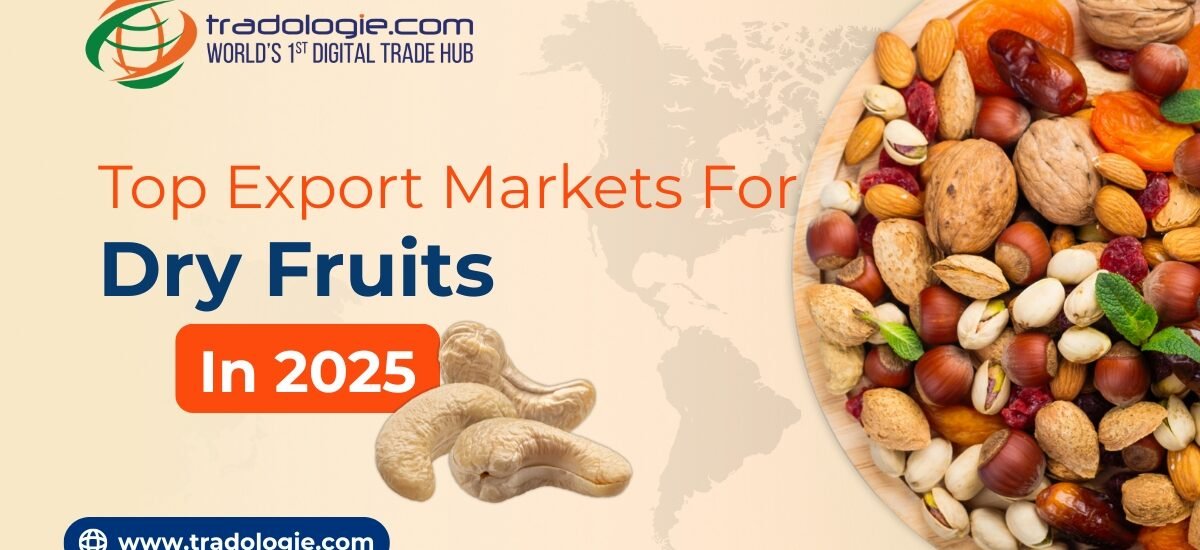We all love one or the other dry fruits, don’t we? It’s a delight to eat them as a snack or blended into bakery treats. However, when it comes to b2b trade, dry fruits represent a niche yet strategically significant segment in the broader scope of global agro commodities. This is true both for their health benefits and their positioning in the value-added food chain. Dry fruits are deeply embedded in consumer wellness trends and institutional food manufacturing, whether featured in packaged breakfast cereals, pharmaceutical nutrition blends, or gourmet snack categories,
From a trade standpoint, they occupy a modest footprint in global commerce for bulk dry fruits exporters. According to OEC data, the global trade of dried fruits reached USD 3.01 billion in 2023, reflecting a slight contraction of 0.69% from the previous year. Over the last five years, however, the category has demonstrated consistent growth at a compound annual rate of 3.77%, indicating underlying demand resilience despite external macroeconomic pressures.
Commercial Relevance: A Niche with Consistent Pull
Dry fruits may not match the volume of commodity grains or oilseeds, but they hold their own in terms of price per metric ton, shelf life, and value chain application. They are used extensively across:
- Breakfast cereals and granola manufacturers
- Functional snack brands and trail mix processors
- Ayurvedic, nutraceutical, and immunity-boosting formulations
- HORECA segments, especially luxury hospitality and airline catering
- Retail-focused gifting and festive pack segments
Each of these sectors demands consistent quality, visual appeal, and food safety compliance—making quality control, packaging, and traceability essential B2B considerations.
Nutritional Properties That Drive B2C Preference
From the consumer’s lens, dry fruits are perceived as concentrated sources of nutrition. Their low water content amplifies calorie and micronutrient density. Here are key nutritional benchmarks often used in product formulation and marketing:
- Almonds: Rich in Vitamin E, magnesium, and healthy fats. Used for heart health and cognitive function products.
- Cashew nuts: High in zinc, iron, and protein. Favored in plant-based dairy and dessert blends.
- Raisins: Packed with natural sugars, potassium, and fiber. Common in breakfast and energy bar segments.
- Figs and dates: High in antioxidants and dietary fiber. Positioned in digestive wellness SKUs and clean-label sweets.
These nutritional advantages feed directly into product positioning, regulatory labeling, and B2C marketing narratives, especially in export-oriented premium food categories.
Trade Metrics and Global Sourcing Dynamics
Despite its high retail visibility, dried fruit remains a relatively minor category in global trade rankings. It stood at rank 662 out of 1217 traded products globally in 2023, accounting for just 0.013% of world trade. With a Product Complexity Index (PCI) of -0.95, it ranked 842 out of 1044, highlighting the relatively low technological intensity required for processing but high dependency on supply chain and origin quality.
Top producers and dry fruit exporters include Iran (for pistachios and dates), the US (for almonds and prunes), Turkey (for apricots and figs), and India (for cashew and raisins). On the demand side, North America, the EU, and parts of the Middle East continue to dominate imports, driven by mature consumer markets and well-established distribution networks.
Health-Driven Branding and Product Innovation
Dry fruits have undergone a brand transformation—from pantry essentials to functional foods. This evolution is primarily fueled by health-conscious consumers seeking gluten-free, high-fiber, and no-added-sugar alternatives to conventional snacks.
For dry fruit exporters and brand developers, this opens several positioning levers:
- Clean-label marketing: Dried fruits naturally support additive-free declarations.
- Portion-controlled packaging: Smaller pouches targeting calorie-conscious consumers.
- Fusion blends: Pairing dry fruits with seeds, probiotics, or dark chocolate for hybrid appeal.
- Immunity and energy claims: Leveraging ingredients like dates, figs, and nuts in nutraceutical formats.
These factors influence not just final-mile marketing but also the way bulk dry fruit exporters present their product catalogs to global buyers. Providing consistent sizing, moisture levels, and contamination-free batches is now non-negotiable.
B2B Sales Enablement: Trade Formats and Procurement Preferences
In the B2B landscape, procurement specifications are often more granular than retail marketing suggests. B2b bulk dry fruit buyers typically demand:
- Uniform sizing (screening standards)
- Low moisture content (below 6–8%)
- Absence of aflatoxins or sulfur-based preservatives
- Packaging compatibility for automation (bag-in-box, nitrogen flush pouches)
Longer shelf life and stable pricing cycles make dry fruits ideal for contract manufacturing and private-label agreements. However, success in B2B depends heavily on origin traceability, shipping documentation, and post-harvest handling—especially for regions with stricter import norms like the EU and US.
Marketing Dry Fruits in a Trade-Focused Context
Unlike fast-moving bulk commodities, dried fruits thrive in targeted marketing ecosystems. For traders, processors, and B2B aggregators, positioning should address:
- Buyer Segment Customization – Tailor offers by buyer category: FMCG brands, retail distributors, institutional kitchens, or direct-to-consumer startups.
- Certifications and Compliance – Highlight ISO, HACCP, BRC, or USDA Organic certifications. Many buyers filter suppliers by certification before price.
- Multi-Use Functionality – Market the same SKU for multiple applications (e.g., chopped cashew for bakery, powdered almond for baby food).
- Storytelling for Export – Origin-based storytelling (e.g., “Afghan figs”, “Goan cashew”, “Turkish apricots”) helps tap into ethnic food channels abroad.
Digital procurement platforms that support live negotiation, verified buyer access, and end-to-end logistics coordination are increasingly bridging the gap between artisanal growers and large-volume dry fruit importers.
Conclusion
Dry fruits might represent a smaller slice of global trade by volume, but their value lies in premiumization, nutritional credibility, and functional versatility. For suppliers, this means going beyond commodity logic—focusing instead on quality differentiation, B2B segmentation, and health-aligned narratives. For buyers, the right sourcing decisions lie at the intersection of traceability, compliance, and consumer relevance.






